How the NBA Was Saved on the Back of a Napkin

Larry O’Brien, fresh off propelling John F. Kennedy to his first Senate term, is busy plotting the young politician's ascent to the presidency, and in Minneapolis, the Westernmost city in the NBA, a professional basketball game is going down to the wire: It's Nov. 22, 1950, and the Fort Wayne Pistons trail the Minneapolis Lakers, the reigning champs, by one point.
But the 7,021 fans who flocked to the arena have dwindled to a small, irate crowd, as boos line the Minneapolis Auditorium. The nailbiter, as it turns out, was borne not from the natural ebb and flow of an entertaining basketball game, but a strategic exploit. Instead of oozing over the dominance of league MVP 6’10” George Mikan, fans are bearing witness to the tactical savvy of Fort Wayne Pistons coach Murray Mendenhall. He gave his point guard Ralph Johnson only one instruction: stall.
For the better part of 48 minutes, under the Pistons’ possession, the ball moves aimlessly from one side of the court to the other. Fans, Lakers’ players, and even the referees (the game’s official paragons for impartiality), implore them to try to score. In desperation, the Lakers resort to intentionally fouling to get the ball back. At the time, however, the rule book awarded a free throw for non-shooting fouls, so the Lakers’ adjustment effectively morphed the game into a glorified free throw shooting contest. In the end, the Pistons alleviate a talent deficiency, eeking out a 19-18 victory over the defending champs. It remains the lowest scoring game in league history.
For coaches, a tactical revolution was born. But professional basketball, a rickety commercial endeavor in its infancy, was dealt its biggest existential threat to date.
In the prophecy of Lakers coach Johny Kundla, ”play like that will kill professional basketball.”
It’s the spring of 1954, and inside the lounge of the Eastwood Sports Center, a bowling alley and coffee shop on the east side of Syracuse, are the three men who tasked themselves with saving the NBA. A half-century later, they have been forgotten in the annals of its history. There’s Danny Biasone, owner of both the bowling alley and the Syracuse Nationals, a central figure in the city’s civic and sporting culture. Beside him is Emil Barboni, the team’s head scout, as well as Leo Ferris, the Nationals GM, and an instrumental force in completing the merger that formed the NBA in 1949.
It’s been eight years, and the league Ferris helped create is perilously close to becoming just another relic of the 1950s. Viewership has plummeted, causing the 18 original teams to dwindle to just nine. As the pace of the game has slowed to a halt, so too has the NBA’s notoriety.
The trio can’t bear to watch the game they love erode at the hands of a statistical revelation, so they’re working on devising their own association.
Not only that, the Nationals, one of the speediest teams in the league, were being stymied from running their ideal offense. They were in search of a solution that would not only save the NBA, but the hopes of their team.
And so it was that, on the back of a napkin, the most important formula in NBA history was born.
It was not the product of a painstaking regression analysis; no lofty arithmetic was required in the process. In fact, they probably didn't even use a calculator. From analyzing box scores from the previous season, they merely deduced that the most entertaining games usually featured each team hoisting about sixty shots, or 120 per game. That number was divided by 48 minutes, or 2,880 seconds, the total time of an NBA game. The end product? 24 seconds.
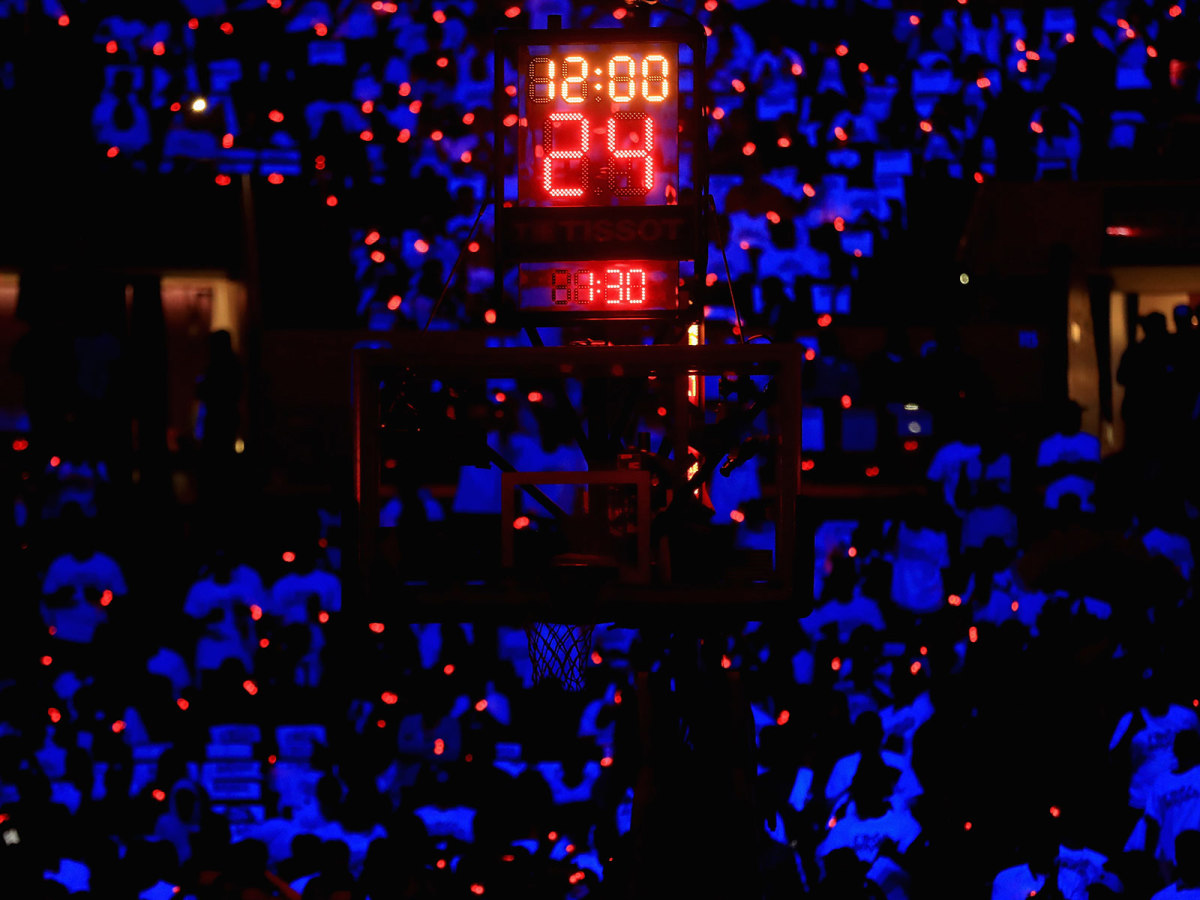
It’s Aug. 10, 1954, and on the westside of Syracuse, a series of owners and executives, from Red Auerbach and Clair Bee to Eddie Gottlieb, Ferris and Biasone, are gathered inside a small, tattered high school gym. The NBA’s leading power brokers, cramped into the metal rafters, nervously anticipated a possible solution to the league’s woes.
Biasone originally organized the first basketball game to incorporate at a different high school, but later opted to change the location to his alma mater, Blodgett Vocational High School. Sean Kirst, a former reporter for the Syracuse Post-Standard infers, “I always thought he must have had sense of the significance of the scrimmage.”
A collection of local college stars, and Nationals players who stuck around town in the summer, like Dolph Schayes and Billy Gabor, comprised the team. Al Cervi, the Nationals’ coach, played and officiated.
Chaos ruled the beginning of the game, and the fears of the pessimists laid bare: The mere notion of a shot clock has struck panic in the players’ minds, and rushed shots start flying off the their fingertips within the first few seconds of every possession. In time, though, an internal metronome begins to develop, and the the players adjust to the pace of the game.
At one juncture, Schayes finds himself with the ball in his hands, with nowhere to go. As the shot clock is set to expire, intuition springs. He slams the ball into the backboard, caroming it into the hands of his teammate, Billy Gabor, which resets the clock and incites the vital question: Does that qualify as a shot?
A timeout is called, and the ruling scions of the league convene to debate the issue. “This basic fundamental rule with the shot clock was decided on their feet,” remarks Danny Schayes, son of the late Dolph Schayes. “They thought about it and thought, if they just allowed people to slam it on the backboard, they could do that all day and make it a strategy.”
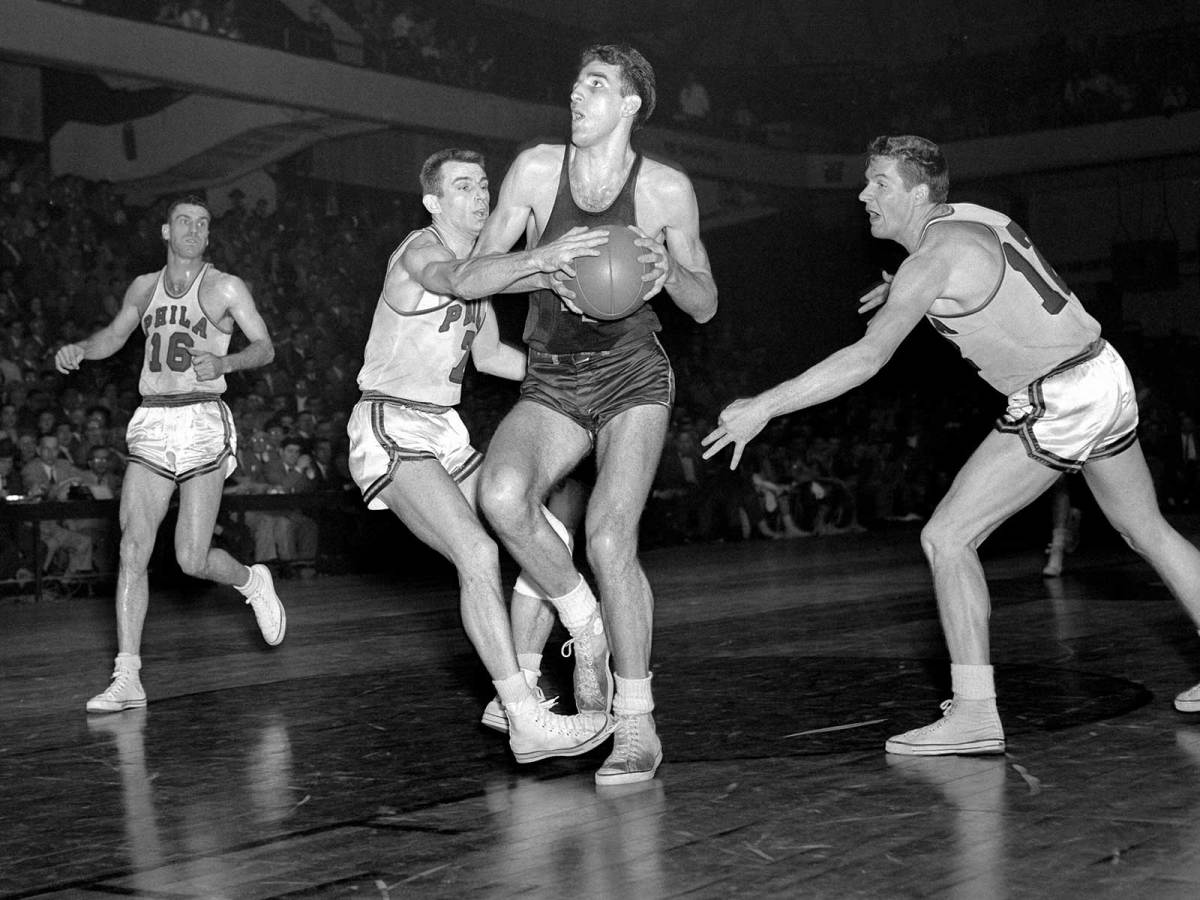
“As you can imagine, any [change] that fundamental was not an easy sell,” continues Schayes, but “the enthusiasm was so immediate that it was adopted right away. It fell into place. It just instantly created a much more pleasing game without fundamentally changing the game. It worked out beautifully.” By tip-off the following season, there was a shot clock being operated in every NBA arena.
The 24-second shot clock has lit the basketball world since its inception. Twenty stubborn years after the NBA, the NCAA would implement a 45-second shot clock, only to reduce it to 35 seconds less than a decade later, and then 30. In 2000, FIBA reduced the maximum length of a possession from 30 seconds to 24.
Of all the potential fixes to today’s game—widening the size of the court, banning intentional fouls, redefining shooting fouls—the length of the shot clock is one of the few rules that remains sacred.
A game that today, is increasingly seen through the lense of near-statistical truths, in an era where algorithms are considered more reliable than human brainpower, was saved on gut intuition. From a napkin-back to a high school gym to a huddle and a snap decision, these are the rules that now govern ballers' lives, an entire multi-billion dollar industry, a cultural artifact.
Sixty shots per team? Sounds about right.
The backboard? Nah, I don’t think it should count.
When the Nationals lost to the Lakers in the 1953 NBA Finals, George Mikan’s dominance down low was tailor-made to suit a slower game. The Lakers dictated the pace, and the Nationals were never able to gather the necessary head of steam. Fast-forward another year, and the Nats found themselves in a wholly different position.
It’s early in the second quarter of Game 7 of the NBA Finals, and the Nationals already trail the Fort Wayne Pistons by 17 points. But unlike seasons past, Fort Wayne can’t grind the action to a halt and seal the game by stalling and turning it into a free throw contest. Nats coach Cervi pulls two starters, Paul Seymour and George King, and inserts Kenville and Dick Farley. They serve as immediate spark plugs, cutting the Pistons’ lead to six by halftime. With twelve seconds left, the game is tied, and the Pistons send King, a weak free throw shooter, to the line. He nails one of two, and Syracuse escapes 92-91, with their first and only championship in franchise history.
None of this happens if they couldn’t amass what has become a defining staple of entertainment in the modern game, the essential consequence of the shot clock: a comeback.
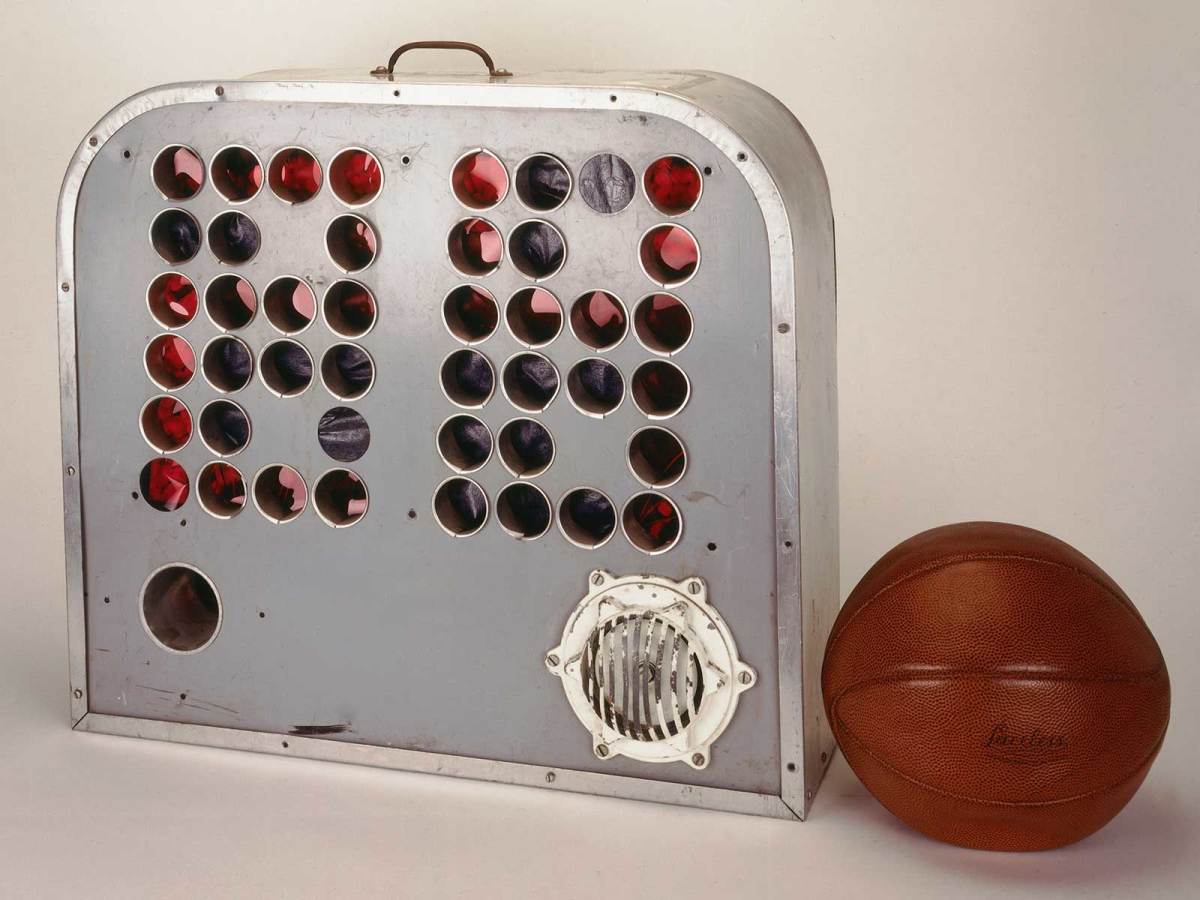
Ferris, however, was not able to partake in the spoils of his success. In December 1954, despite the fact that the first-place Nationals were fielding their best team in franchise history, and team revenue was on the rise, the board of directors voted to accept his resignation.
In the intervening years, his contributions were stricken from memory. In its section on the history of the shot clock, even the NBA’s official encyclopedia fails to mention him. Biasone, who was inducted in the Naismith Hall of Fame posthumously, has enjoyed the lion’s share of credit for inventing the formula. But according to Ferris’s family, that interpretation of history has cast a shadow over his contributions.
It’s a summer night in 2014 and inside his home in Brookline, Massachusetts, Christian Figueroa is interrupted from his slumber by the voice of a dead man.
“It said 'Leo Ferris, Leo Ferris, Leo Ferris.'”
Figueroa, Leo’s great nephew, has been grieving the death of Leo’s daughter, Jamie, who succumbed to Huntington’s disease, the same ailment that killed Leo 20 years prior. That, along with his son’s burgeoning interest in basketball, reignited his frustration and reinvigorated a familial quest. “It literally woke me up,” says Christian. “This is what reinvigorated my passion. I had been playing with my son for the last couple weeks and something happened in the middle night that made the connection of like, ‘Oh my God, you still haven’t told your son.’ It reinvigorated in me a desire to share this part of our family history with him. It was almost out of a movie.”
Basketball was developing into a connective tissue for father and son, yet the younger Christian was unaware of his shared ancestry with one of the sport’s vital figures. Forget the Naismith Hall of Fame; he couldn’t walk into the Syracuse Hall of Fame and expect to find a mention of Leo.
Figueroa began tirelessly mining old newspaper articles, compiling a Wikia page with evidence of Ferris’s importance to the NBA and the Nationals. It includes anecdotes from the late Jack Andrews, who reported on the Nats for the Syracuse Post-Standard, and would recall watching Ferris scribble down different formulas on barroom napkins. Another excerpt cites Bob Sexton, the Nats publicity director, crediting Ferris for pushing the shot clock at a team banquet.
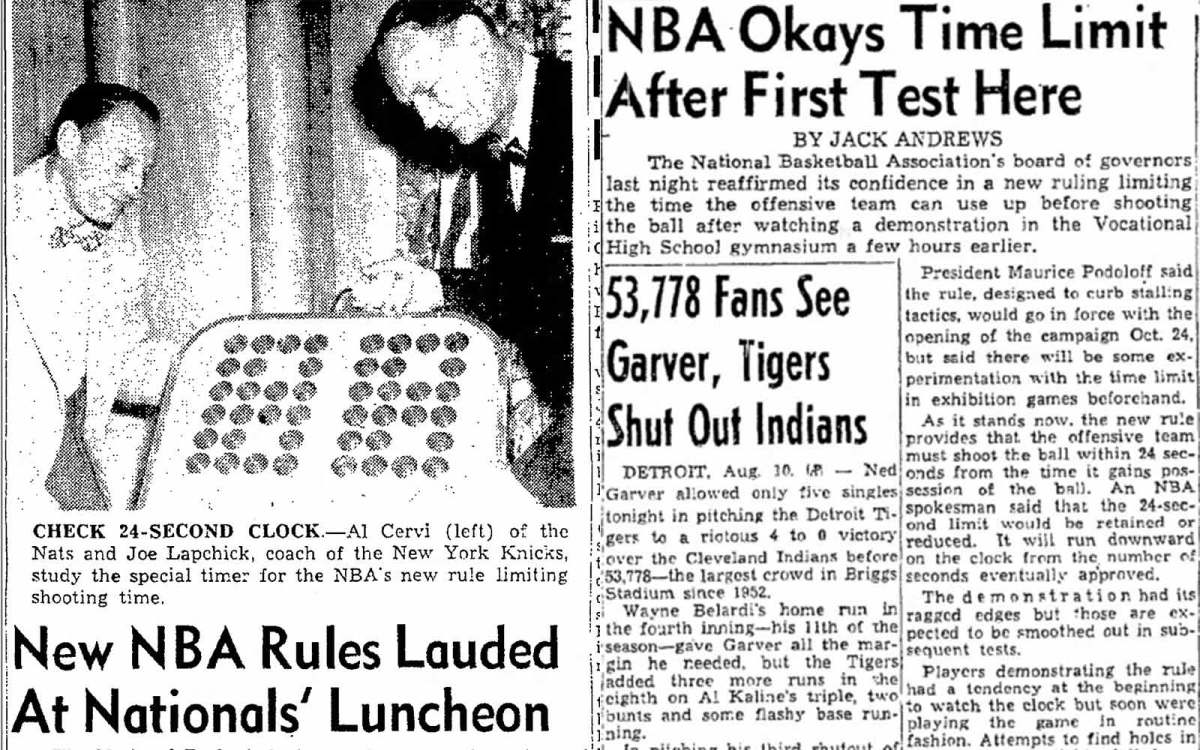
“Leo was a wizard with numbers all his life,” explains Figueroa. “We know Leo and Danny were trying to get to the bottom of it. They worked for the same goal, but the person who developed the formula and numbers was definitely Leo. This is what Leo was saying for quite a long time before he died. Once he leaves, the narrative of Danny being the sole inventor of the shot clock, nobody was there to dispute that. Certain people took credit for certain things that he’d done. Then, once he became ill, it was harder for him to speak up.”
Years of periodically lobbying the Syracuse Hall of Fame, requesting each new piece of Ferris’s story be added to his file, finally culminated this year into a nomination. He will be inducted posthumously, on Oct. 16.
And there there’s Barboni, who was a World War II trenchmate of Howard Hobson, the basketball coach at the University of Oregon and, later, Yale. In Hobson’s doctoral thesis at Columbia, a 13-year study later named “Scientific Basketball”, he became the first person to advocate for a shot clock. The two organized and coached basketball games with fellow soldiers, and after the war, Barboni kept close tabs on his old pal’s basketball career. So in March 1954, when the Post-Standard ran a banner headline on Hobson’s shot clock proposal being denied by the NCAA, it’s very unlikely that Barboni missed it. Paul Seymour, a former Nat, often said Barboni, too, was never given the credit he deserved.
None but the three could definitively state who had the “Eureka!” moment. History is wrought with blind spots, but this much is clear: Lasting ideas are often the product of the painstaking tinkering of multiple authors, long histories and strong peddling. The trio in the lounge of the Eastwood Sports Center would brainstorm, obsess over every detail, and quibble for hours on end in search of a solution. From Hobson’s mouth to Barboni’s, to the mathematical wizardry of Ferris, and Biasone’s weight with the NBA rules committee, in that moment and in the face of that problem, there might never have been a better combination of people to solve it.
In fact, it may have been one of the only moments that Ferris and Biasone saw eye to eye.
Biasone was, in the words of Danny Schayes, an “old school Italian”—the family patriarch, who ran his team like a family business, and took the utmost pride in the Nationals being a pillar of civic life. He considered bringing the All-Star Game to Syracuse in 1961 one of his crowning accomplishments, because he wanted to showcase it to the rest of the country as a world-class city. In fact, the team was christened the Nationals because Biasone wanted to market the city as the epicenter of American life.
Ferris, on the other hand, was a creative mercantilist. He was constantly trudging ahead, searching for an edge. In 1946, prior to the merger of the NBL and BAA, he was named the general manager of the NBL’s Buffalo Bisons. That offseason, he became the first GM in the history of professional basketball to usher in integration. Earl Lloyd was still a freshman at West Virginia State when Ferris signed William “Pop” Gates and Bobby Daugherty. The halftime show, meanwhile, was in its trial stage. Dog and pony shows, literally, were becoming a regular part of the attraction of an NBA game. Ferris pushed matters further, and in an effort to drive women to the stands, became the first GM to organize celebrity halftime shows. A dog jumping through a hoop is adorable, sure, but it couldn’t drive an audience like Duke Ellington performing on a revolving stage.
As electrifying of a change as it was, the conception of the shot clock represented unifying principles. It was a fusion of new and old, an innovation to be sure, but one dedicated to restoring the game to its original norms—a natural consensus-builder. Where Ferris saw evolution, Biasone saw preservation. And where Biasone was interested in restoring grace, Ferris was interested in capitalizing on it.
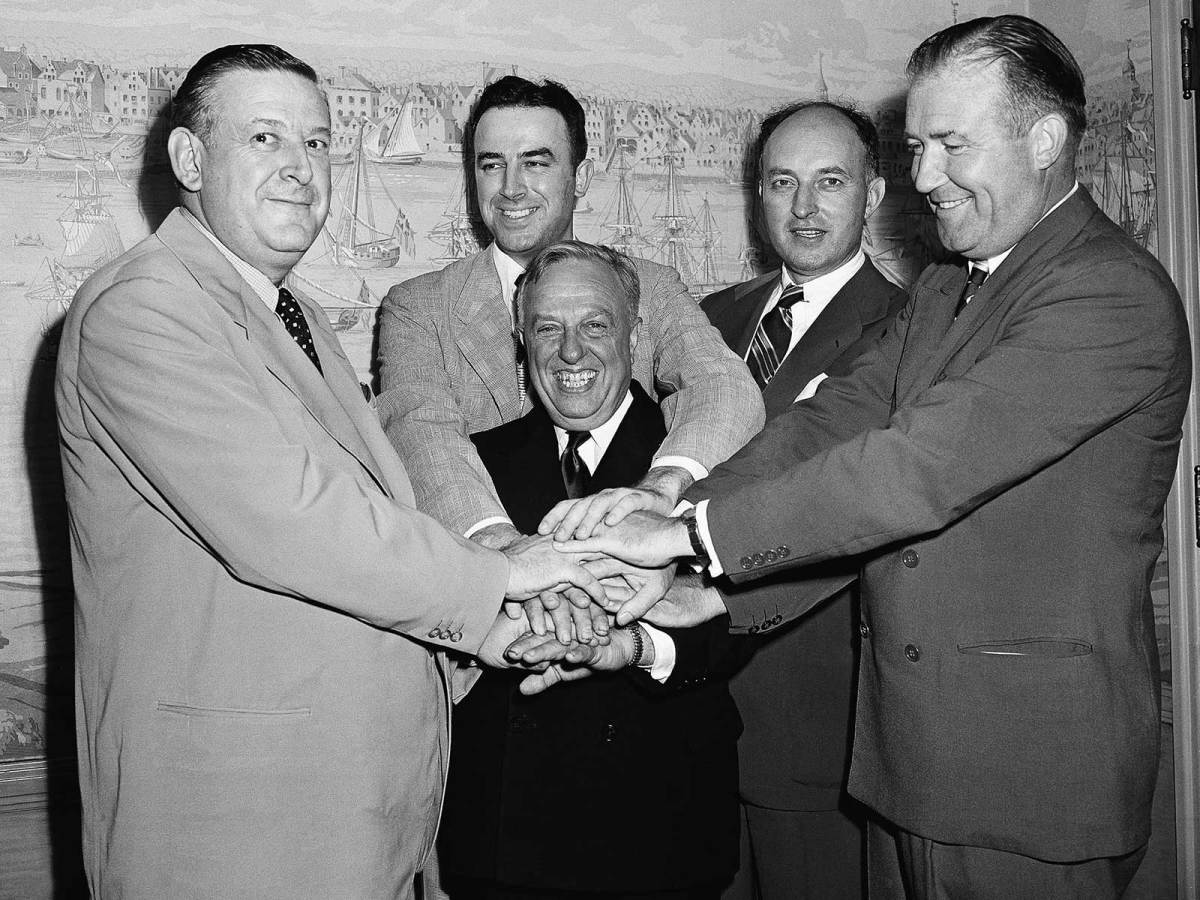
The details surrounding Ferris’s departure are murky, at best—an extension negotiation conducted in bad faith, nondescript quibbles with the team’s board of directors. Before his resignation, rumors were being floated that Ferris wanted to move to Detroit, a notion that surely would have angered Biasone. “He was pragmatic,” says Kirst of Ferris. “He was a businessman.”
In Kenville’s estimation, “the strained relationship between Leo Ferris and Danny Biasone had to do with him leaving.” This much is clear: The two men, at their core, were fundamentally different, Leo the Silicon Valley frontiersman to Biasone’s Rust Belt pride.
The 1954–1955 season was the progenitor to the large–scale corporation that now fields 30 teams and generated $5.9 billion in revenue in the 2015–2016 season. Thanks to the advent of the shot clock, the pace of the game immediately increased, and team scoring shot up by fourteen points per game. By 1958, the average was 106 points per game, and more importantly, attendance had increased by 40%. Early in the shot clock’s inaugural season, the financially strapped Baltimore Bullets were forced to fold. It would be the last time an NBA team ever folded.
League revenue began to swell like never before, as did the NBA’s burgeoning place in the cultural lexicon.
So much so that the shot clock that Biasone so passionately pushed for was threatening to push Syracuse out of the door. To boot, the popularization of commercial air travel opened the floodgates for Westward expansion across industries. The NBA salivated at the notion of pitching a tent in California, and as a result, Biasone had spent years resisting pressure to move the Nationals from Syracuse—the once-glimmering hub of American manufacturing, whose population peaked in 1950—to San Francisco.
By 1963, Biasone grew tired of fighting and sold the team to Philadelphia. He never stopped loving basketball, but in his later years, Biasone grew weary of the NBA’s corporate standing, the way he perceived industry to be distorting the purity of the game.
After Biasone’s death, the Eastwood Sports Center was demolished.
In downtown Syracuse, a monument to the shot clock, erected in 2005, stands in Armory Square. It is the city’s only enduring record of its legacy in NBA history.
The 2004–2005 NBA season gave birth to the pairing of Mike D’Antoni and Steve Nash, a wily, developing floor general who would eventually race his way to two MVP trophies. The moniker, Seven Seconds or Less, was a direct inspiration of their attack: To attempt a quality shot as early as possible, leaving significant time on the shot clock and ending possessions early. They took the league by storm, blitzing opponents on offense and finishing with a 62-20 record.
Basketball, like any self-contained ecosystem, is inextricably destined to change. Over time, manipulations give way to evolution, and the game is turned over on its head. The difference between D’Antoni and Mendenhall, the Fort Wayne coach who devised the stall, is that while Mendenhall threatened to displace the game, the Suns electrified it. They made basketball more fun.
Mendenhall’s innovation was truly a gimmick, designed to flatten talent disparities. D’Antoni’s strategy merely changed the type of talent that was valued, and in doing so, irrevocably changed the course of the game. This past season, the league’s average pace, at 96.4 possessions per game, surpassed those Suns by a half-possession, while the Golden State Warriors, eventual champions, proprietors of D’Antoni’s legacy, used 99.8 possessions per game. And as the rest of the league continues to catch up, even that figure could one day be left in the dust.
It’s June 12, 2017, and the Warriors are squaring off against the Cavaliers. At a breakneck pace, with an aesthetically pleasing style, tailor-made for the digital age, a captive TV audience of over 25 million viewers will watch as the Warriors cruise to their second championship in two years. They will be christened as the gold standard in the so-called “pace and space” era.
The NBA has evolved into a year-round corporate enterprise, a universally recognized American institution. The game’s biggest stars, LeBron James, Kevin Durant and Steph Curry, spar for 48 minutes as titans of industry, like Chris Rock, Snoop Dogg and Aaron Rodgers take in the action from courtside seats that retailed, for the first time in history, at six figures. At halftime, the Jabbawockeez, of America’s Best Dance Crew fame, performed to a sold-out crowd of over 19,000 fans. LeBron nails an off-balance jumper over Durant’s protruding arms, and at the 6:27 mark of the first quarter, Cleveland has already eclipsed the 19-point mark that spawned the NBA’s nightmares. Somewhere in the stands, the ghost of Leo Ferris smiles.
